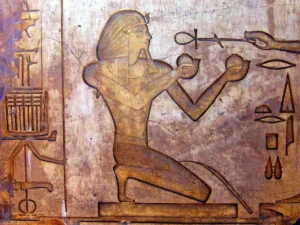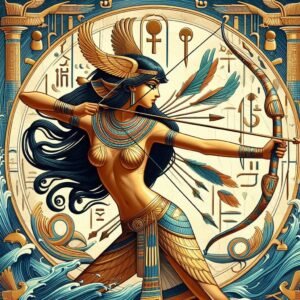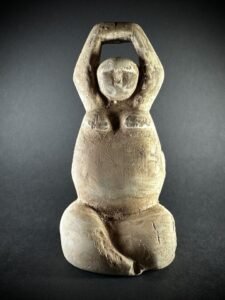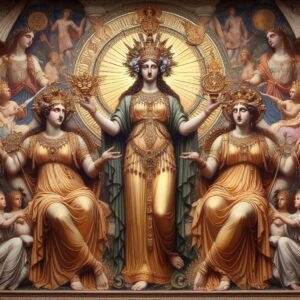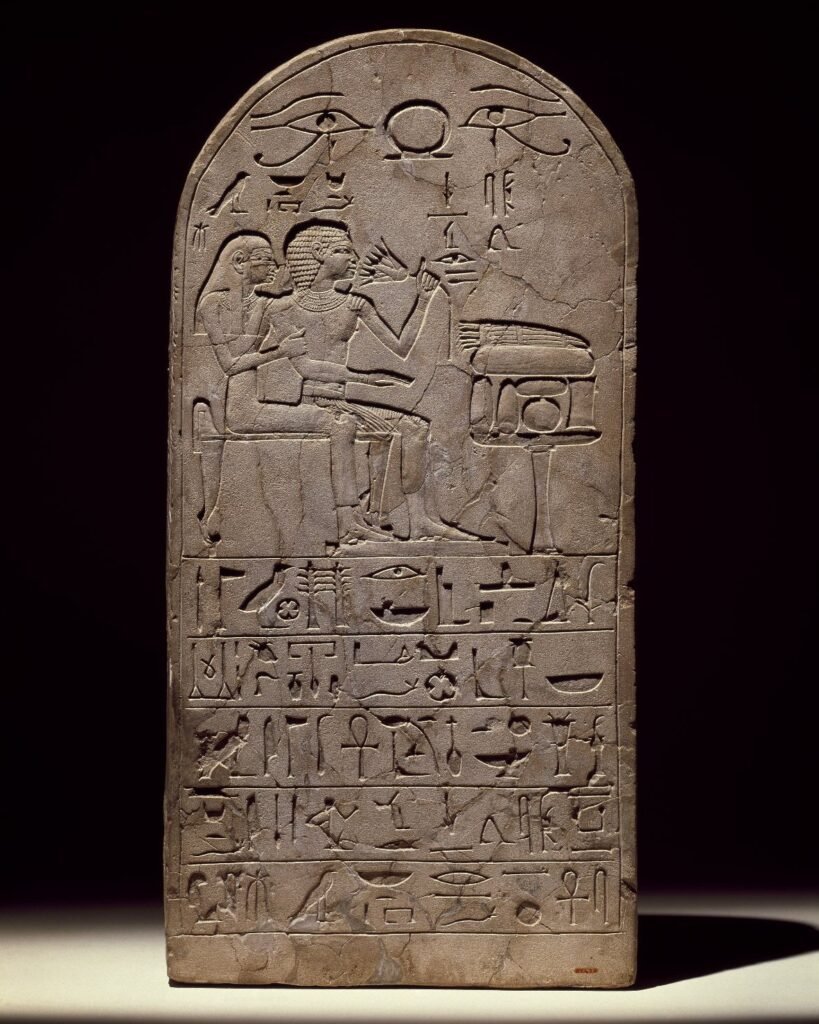
Senres and his wife Hormose
Senres and Hormose
Senres and his wife Hormose are two ancient Egyptian individuals known primarily from inscriptions found in the tomb of Senres at Saqqara. They lived during the Old Kingdom period, likely in the 5th Dynasty, which spanned from about 2494 to 2345 BCE.
Senres is known as a high-ranking official or noble during the 5th Dynasty. He held the title of “Overseer of the Treasury” or a similar position, indicating that he had significant administrative and financial responsibilities within the royal court.
He was involved in the management of royal assets and served in a capacity that would have placed him in close proximity to the Pharaoh and the royal family.
His tomb, located in the Saqqara necropolis, is a notable site where many details about his life and family have been preserved.
Hormose is mentioned in the inscriptions within the tomb, and she is referred to as Senres’ wife. Although not much is known about her life specifically, her inclusion in the inscriptions suggests that she was considered important in Senres’ family structure.
In the tomb of Senres, we find evidence of the couple’s relationship with the gods, particularly in their efforts to secure favour and protection for the afterlife.
Senres’ title, “Overseer of the Treasury,” is significant because it placed him among the upper echelons of Egyptian society, where wealth and access to power were often tied to control over resources, particularly those belonging to the Pharaoh or royal family.
The Gods of the Old Kingdom
The Old Kingdom period, particularly the 5th Dynasty, was marked by increasing bureaucratic complexity and the consolidation of power within the Pharaoh’s administration. As a noble or royal official, Senres would have been part of this growing state apparatus, helping to manage the wealth of the kingdom.
There is no definitive record specifying which exact gods Senres and Hormose were honouring in their tomb. While we can infer that they likely honoured prominent deities associated with the afterlife and royal power (like Ra, Osiris, Anubis, and possibly Horus), there are no direct, specific mentions of the deities they worshipped in the inscriptions found in their tomb at Saqqara.
Here are some of the most likely gods that Senres and Hormose may have honoured:
Re (Ra)
The sun god Re (or Ra) was the most important deity in the Old Kingdom. As the ruler of the heavens, Re was associated with the Pharaoh’s power and the continuity of the world. The worship of Re was central to the 5th Dynasty Pharaohs, who often referred to themselves as the sons of Ra.
Senres, as a high-ranking official, would have been expected to offer devotion to Re, especially as part of his religious and funerary practices. The idea of the Pharaoh being the living embodiment of Re and ensuring harmony through the sun’s movement was vital to Egyptian cosmology.
Osiris
The god Osiris, associated with the afterlife, death, and resurrection, would certainly have been part of their religious practices, particularly in relation to funerary rituals. Osiris was the god of the underworld, and it was believed that he would offer protection and rebirth to the deceased.
Osiris’ role in the afterlife would have been critical for Senres’ and Hormose’s hopes for a peaceful and prosperous journey after death. The Opening of the Mouth ritual, an essential part of Old Kingdom burials, was often performed in honour of Osiris.
Horus
Horus, the sky god and protector of the living Pharaoh, may also have been honoured in their tomb. As the divine son of Osiris, Horus was associated with kingship, protection, and the continuation of the royal family.
If Senres held a high-ranking position, there might be scenes of offering to Horus as a protector of the tomb and the spirit of the deceased.
Anubis
Anubis, the god of mummification and the protector of the dead, was also highly revered in the Old Kingdom. He was often associated with the funerary rites, particularly the embalming process and the safeguarding of the deceased’s journey into the afterlife.
It is highly probable that Senres and Hormose honoured Anubis as part of their efforts to ensure proper protection and transformation after death.
Ptah
Ptah, the god of craftsmanship and creation, was also an important figure, particularly in Memphis, which was a major religious and political centre during the Old Kingdom and 5th Dynasty. Ptah was the creator god associated with artistic creation, and his influence extended over the administrative elites and artists of the time.
Given that Senres held a high official position, it is possible that Ptah, being the patron of the city of Memphis, would have been a part of their religious practices.
Isis
Isis, the wife and sister of Osiris, was a powerful deity in her own right, associated with magic, healing, and protection. She was often invoked for her role in the protection of the dead and for guiding souls through the afterlife.
As an important goddess for funerary and protective practices, she may have been honoured in some form by the tomb’s inscriptions, particularly in relation to ensuring the safety of Senres’ and Hormose’s afterlife journey.
Other Local and Household Gods
Besides the major deities, there may have been references to smaller, household gods or local deities specific to Senres’ family or regional area. For example, some gods were closely linked to specific regions or personal protection.
Symbolism of the Lotus
Also included in this stela, Senres is shown seated, holding a lotus. The lotus in ancient Egyptian art and symbolism holds deep significance, and its depiction in the stela of Senres and Hormose is likely a meaningful addition to their representation. The lotus was an important symbol in Egyptian culture and religion, with various interpretations depending on the context. Here are the key meanings and symbolic aspects of the lotus in ancient Egyptian culture, which would apply to its use in the stela:
Symbol of Creation and Rebirth
The lotus is often associated with creation, particularly in the context of the sun and the creation myth. The lotus flower opens at dawn and closes at night, symbolizing the sun’s cycle of rebirth. In the Heliopolitan creation myth, the lotus is said to have emerged from the primeval waters (Nun), with the sun god Ra being born from it.
By holding the lotus, Senres may be symbolically aligning himself with the forces of creation and renewal. It could represent a connection to the divine process of rebirth and the promise of eternal life, which was central to Egyptian religious beliefs.
Symbol of the Sun
The lotus is also connected to the sun god Ra. The flower’s opening each morning at dawn and its closing at sunset represent the daily journey of the sun across the sky. In this context, the lotus was considered a symbol of the sun’s power and the life-giving energy it provided.
Since Senres is depicted holding a lotus, it could signify his association with the divine power of Ra, aligning him with the sun’s regenerative qualities, perhaps reflecting his role as a high-ranking official or priest. It could also imply his role in maintaining cosmic order and divine favour.
Symbol of Purity and Transformation
The lotus is often linked to the concept of purity, as it grows in muddy waters but emerges clean and beautiful. This symbolism could suggest that Senres and Hormose were seen as being purified or transformed by their connection to the divine. This purity also has an association with the afterlife, where the soul, like the lotus, might emerge from the “mud” of earthly existence to find spiritual elevation.
Holding the lotus could imply that Senres is purified and ready for his journey into the afterlife, a common theme in Egyptian tomb art, where offerings and symbols were included to ensure a favourable passage to the next world.
Symbol of the Nile and Fertility
The lotus is also associated with the Nile and the fertility it brings to the land of Egypt. The flower often grows in the waters of the Nile, and its seasonal blossoming was linked to the annual flooding of the river, which was essential for agriculture and life in Egypt.
Link to the Goddess Hathor
The lotus is also linked to Hathor, the goddess of love, beauty, and motherhood. In some cases, the flower was seen as a symbol of her nurturing and life-giving qualities. If Senres and Hormose were associated with religious roles, particularly in relation to the sun or the afterlife, the lotus could also be a symbol of their connection to Hathor, especially in a protective and regenerative capacity.
The stela’s context—being part of Senres’ tomb—suggests that the lotus was intended to communicate Senres’ transition into the afterlife and his connection to divine and cosmic forces. There might be specific references to Senres’ role in the royal court or religious practices as an official responsible for overseeing royal resources, as suggested by his title of “Overseer of the Treasury.”
Numeric Symbology of the lotus
Another aspect of the inclusion of the lotus flower, may include its numeric symbology. In ancient Egyptian symbolism, whilst the lotus flower did not have a direct or widely recognized numeric significance in the way some other symbols (such as the ankh or scarab) were imbued with specific numerical meanings. It does, however, have some associations with numerology and symbolic numerals based on its appearance and the broader symbolic and cultural context in which it was used.
The Number 4
The lotus flower often has four petals or is depicted in a way that suggests four stages of growth (such as its bloom at dawn, its full opening, its closing, and its eventual transformation). The number 4 could be linked to this cycle, representing completeness or the natural cycles of life, death, and rebirth.
In Egyptian symbolism, the number 4 was also associated with stability and completeness. It represented the four cardinal directions, the four pillars of the world, or the four sons of Horus. Therefore, the lotus, with its potential association with four parts, could be seen as a symbol of wholeness or divine order, particularly in the context of its use in religious or funerary art.
This reference to the the four cardinal directions, can also be associated with the four sides of the pyramid, and also, the four primary archetypes – the four pillars that hold up and define the the place in space and time which the universe exists.
Just for fun, let use try to assign who those deities of the directions may have been.
We could now suggest that the four pillars — earth, water, fire, and air — correspond to both elements and cardinal directions. The association of these elements with specific directions gives a much deeper structure to our potential understanding the cosmic order and balance perceived by the Egyptians.
Elemental Directions and Deities
Earth (South / Down)
Element: Earth represents stability, the material world, and the underworld. It’s the foundation of existence and where life begins (in the form of birth, creation, and death). It is also the location of the underworld.
Direction: South, symbolizing the underworld (the realm of Osiris and the deceased). The south is associated with the fertile Nile Delta, which is essential for life and prosperity.
Archetype: Osiris — the god of the underworld and resurrection, ruling the domain of the dead. Earth and Osiris can be seen as the foundation for renewal and continuity, representing life after death and spiritual regeneration.
Fire (North / Up)
Element: Fire represents transformation, purification, and the heavenly realm (associated with the sun and divine energy).
Direction: North, symbolizing the opposite of the underworld, and the direction of heavenly power, divine light, and energy. Fire could also symbolize the sun’s radiant power, which rises in the east but is often linked to the North (in the sense of the sun’s zenith or the celestial sphere).
Archetype: Atum — the father god, creator, and force of creation, symbolizing divine light and power.
Water (West/Left)
Water (West)
Element: Water represents the primordial waters of Nun, chaos, and creation. Water is the source of life and is often depicted as both life-giving and destructive.
Direction: West, the setting sun, symbolizes the boundary between life and death. The west is also the realm where the sun dies and is associated with the afterlife, and the deceased travel to meet Osiris.
Archetype: Nun (primeval waters) — the god of chaos and the formlessness from which creation emerged. Nun is the source of all creation, the divine waters that held the potential for life.
Air (East)
Element: Air represents movement, breath, and life force. It is tied to intellect, thought, and communication.
Direction: East, the rising sun, symbolizes new beginnings and spiritual awakening. It is the origin of life and creation, as the sun rises in the east, bringing light to the world.
Archetype: Nut (Sky Goddess) – Represents heavens, the firmament, and creation. The east is the source of light and new beginnings, marking the birth of the sun each day.
Subscribe to our post updates - Don't miss a thing!!

